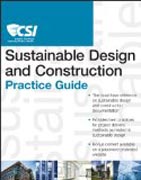
The CSI Sustainable Design and Construction Practice Guide
Construction Specifications Institute,
The CSI Sustainable Design and Construction Practice Guide is a compilation of information and recommended best practices for those who participate in the design and construction of commercial–level sustainable facilities. It offers guidelines and standards for applying sustainable design and construction principles in practical terms. This Practice Guide includes an overview of sustainable design standards and rating systems; an overview of green products and systems, and how to evaluate them; the lifecycle of a building; and the roles and responsibilities of members of the design and construction team. INDICE: Preface ix Acknowledgments xi Chapter 1 Sustainable Design and Construction 1 1.1 Definitions 3 1.1.1 Building Energy Conservation 3 1.1.2 Building Energy Effi ciency 3 1.1.3 Embodied Energy 3 1.1.4 Environmental Product Declaration 4 1.1.5 Green Building 4 1.1.6 Greenwashing 4 1.1.7 Heat Island Effect 4 1.1.8 High–Performance Building 4 1.1.9 Historic Investment Tax Credit 4 1.1.10 Life Cycle Assessment 5 1.1.11 Net Zero or Zero Energy Building 5 1.1.12 Product Category Rule 5 1.1.13 Recycling 5 1.1.14 Renewable Resources 5 1.1.15 Renewable Energy 6 1.1.16 Reuse 6 1.1.17 Sustainability 6 1.1.18 Sustainable Design 6 1.1.19 Sustainable Construction 6 1.1.20 Sustainable Management 6 1.2 Building Codes 7 1.2.1 International Codes and the International Code Council 7 1.2.2 Emerging Trends in Building Codes 9 1.3 Reference Standards 11 1.3.1 ASHRAE Standard 52.2, Method of Testing General Ventilation Air–Cleaning Devices for Removal Efficiency by Particle Size 11 1.3.2 ASHRAE Standard 55, Thermal Environmental Conditions for Human Occupancy 11 1.3.3 ASHRAE Standard 62.1, Ventilation for Acceptable Indoor Air Quality 12 1.3.4 ASHRAE Standard 90.1, Energy Standard for Buildings Except Low–Rise Residential Buildings 12 1.3.5 ASTM E60 Committee on Sustainability 14 1.4 Green Building Rating Systems 15 1.4.1 Domestic (USA and Canada) Systems 16 1.4.2 International Systems 25 Chapter 2 Roles and Expectations of the Design and Construction Team 47 2.1 Owner Team 47 2.1.1 Roles and Responsibilities 47 2.1.2 Owner’s Expectations 48 2.2 Design Team 49 2.2.1 Roles and Responsibilities 49 2.2.2 Design Team Expectations 50 2.3 Product Manufacturers and Representatives 51 2.3.1 Role and Responsibilities 51 2.3.2 GreenFormat™ 53 2.3.3 GreenSpec® 55 2.3.4 Environmental and Sustainability Product Information 55 2.3.5 Corporate Sustainability Reporting 55 2.4 Contractor Team 56 2.4.1 Roles and Responsibilities 56 2.4.2 Contractor’s Expectations 58 2.5 Commissioning Authority/Agent 59 2.5.1 Roles and Responsibilities 59 2.5.2 Systems Subject to Commissioning 62 2.6 Facility Manager 63 2.6.1 Roles and Responsibilities 63 2.6.2 Facility Manager’s Expectations 64 Chapter 3 Sustainable Design and Construction Best Practices 67 3.1 Site Optimization 67 3.1.1 Site Selection Best Practices 68 3.1.2 Site Design Best Practices 72 3.1.3 Site Construction Best Practices 74 3.2 Energy Performance and Conservation 76 3.2.1 Energy Demand 76 3.2.2 Renewable Energy Supply 78 3.2.3 Performance Maintenance and Improvement 79 3.3 Water Use and Conservation 80 3.3.1 Outdoor Water Use Reduction 80 3.3.2 Indoor Potable Water Use Reduction 80 3.3.3 Process Water Use Reduction 81 3.3.4 Reused, Recycled, and Reclaimed Water Use 82 3.4 Materials and Resources 82 3.4.1 Material Design 82 3.4.2 Material and Resource Construction 86 3.5 Environmental Quality 87 3.5.1 Indoor Environment 88 3.5.2 Outdoor Environment 89 3.5.3 Construction Indoor Air Quality 90 3.6 Historic Preservation and Rehabilitation 92 3.6.1 Historic Rehabilitation Opportunities 93 3.6.2 Financial Opportunities 95 Chapter 4 Green Product and System Evaluation 97 4.1 Identify Project Criteria 97 4.1.1 Owner’s Project Requirements 97 4.1.2 Basis of Design 98 4.1.3 Project Budget and Schedule 99 4.1.4 Federal Mandates 99 4.1.5 Funding Opportunities 102 4.1.6 Applicable Codes and Regulations 103 4.1.7 Sustainability and Historic Preservation 105 4.1.8 Green Building Rating Systems 108 4.2 Preferred Material and Product Attributes 109 4.2.1 Introduction 109 4.2.2 Life Cycle Analysis 110 4.2.3 Raw Material Attributes 110 4.2.4 Material and Energy Effi ciency 111 4.2.5 Effi cient Use of Water 116 4.2.6 Waste Reduction or Elimination 116 4.2.7 Local/Regional Materials and Manufacturing 119 4.2.8 Recycled Content and Recyclability 119 4.2.9 Materials Reuse 120 4.2.10 Low–Emitting Materials 120 4.2.11 Bio–Based Materials 122 4.2.12 Certified Wood 123 4.2.13 Sustainable Use of Site Timber 124 4.3 Evaluating Sustainability Options 124 4.3.1 Product Certifi cations 125 4.3.2 Labeling 129 4.3.3 Materials Evaluation Guidelines and Resources 131 4.4 Impact of Choice 133 4.4.1 Life Cycle Analysis 133 4.4.2 Evidence–Based Design 134 4.4.3 Sustainable Return on Investment 135 4.4.4 Operations and Maintenance 136 4.4.5 Indoor Environmental Quality and Occupant Health 137 4.4.6 Impact of Choice 138 Chapter 5 Sustainable Design and Project Delivery 139 5.1 Project Delivery 140 5.1.1 Design–Bid–Build 141 5.1.2 Design–Negotiate–Build 142 5.1.3 Design–Build 144 5.1.4 Construction Management 146 5.1.5 Owner–Build 148 5.1.6 Integrated Project Delivery 149 Chapter 6 Construction Documentation Practices 153 6.1 Contract Issues 153 6.1.1 Owner–Design Professional Agreements 153 6.1.2 Owner–Contractor and Integrated Project Delivery Agreements 157 6.1.3 Contractual Responsibilities 160 6.2 Integration of Sustainable Design Requirements 161 6.2.1 Sustainable Design Rating System Influences 161 6.2.2 Division 01 Concept 162 6.3 Construction Specifications 163 6.3.1 Role of Specifications 163 6.3.2 Procurement and Contracting Requirements Group 164 6.3.3 Division 01—General Requirements Subgroup 166 6.3.4 Work Results Specifications Sections 177 6.4 Construction Drawings 191 6.4.1 Role of Drawings 191 6.4.2 Alternates 192 6.4.3 Temporary Facilities 193 6.4.4 Facility Construction 195 6.4.5 Facility Services 196 6.4.6 Site and Infrastructure 196 INDEX 199
- ISBN: 978-1-118-07855-6
- Editorial: John Wiley & Sons
- Encuadernacion: Rústica
- Páginas: 224
- Fecha Publicación: 26/12/2013
- Nº Volúmenes: 1
- Idioma: Inglés
